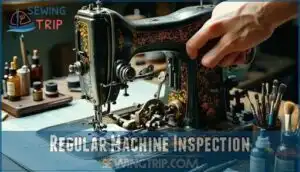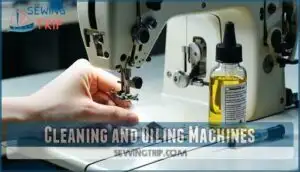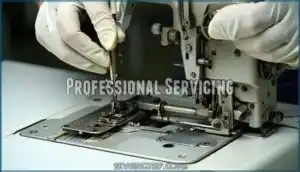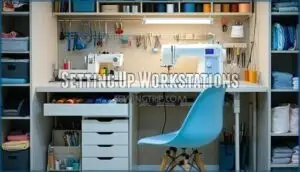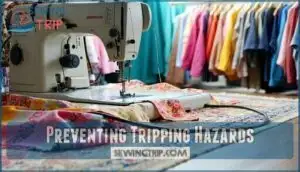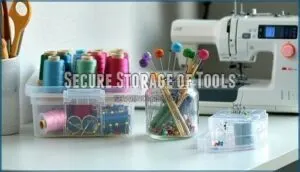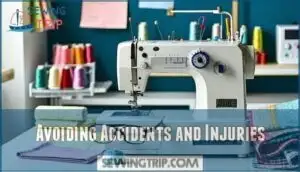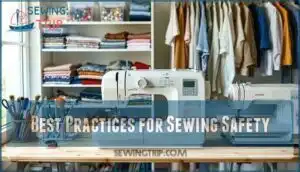This site is supported by our readers. We may earn a commission, at no cost to you, if you purchase through links.
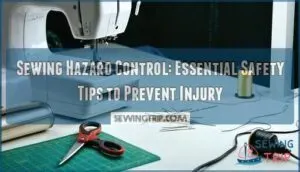
Keep sharp items like scissors, rotary cutters, and needles in designated containers when not in use.
Always cut away from your body and use blade guards on rotary cutters.
Check electrical cords regularly for fraying or damage.
Pin cushion alternatives, such as magnetic holders, prevent scattered pins that become stepping hazards.
Maintain good lighting to reduce eye strain and avoid accidents.
Store thread spools securely to prevent tripping over loose ends.
Remember that even experienced sewers can benefit from updating their safety knowledge—small changes in habits can prevent major mishaps, and it is crucial to handle tools properly, keep the workspace organized, and be aware of potential hazards to ensure good lighting and prevent accidents, which can be achieved by following simple rules such as cutting away from the body.
Table Of Contents
Key Takeaways
- Organize your workspace properly – Keep sharp tools in designated containers, use magnetic pin holders instead of scattered pins, maintain good lighting to prevent eye strain, and route electrical cords safely to avoid tripping hazards.
- Handle tools with respect – Always cut away from your body, use blade guards on rotary cutters, replace dull or damaged tools immediately, and never hold pins in your mouth – use thimbles and proper storage instead.
- Maintain your equipment regularly – Inspect electrical cords for damage, clean lint buildup from your machine, schedule professional servicing annually, and unplug machines before making any adjustments.
- Practice safe habits consistently – Take breaks every 30-45 minutes to prevent fatigue, maintain proper posture with ergonomic seating, dispose of broken needles in secure containers, and supervise children and pets around your sewing area.
General Sewing Safety
Sewing combines creativity with precision, but it also involves sharp tools, electrical equipment, and potentially hazardous materials that require careful handling.
You’ll protect yourself and others by following basic safety principles that prevent common accidents like cuts, burns, and electrical shocks.
Handling Sharp Tools
Sharp tools demand respect in your sewing space. Store needles in secure containers and pins in wrist pincushions – never in your mouth.
Handle scissors with blades pointing away from your body. Use thimbles for hand sewing protection.
Keep rotary cutters closed when not in use. Establish a no-fingers zone around moving needles.
Replace dull or damaged tools immediately to prevent slipping accidents. Consider using ergonomic thread snips for safer and easier cutting.
Electrical Safety Precautions
Power up your sewing machine safely by following electrical safety precautions. Always unplug appliances before making adjustments or repairs to prevent electrical hazards.
Use surge protectors with at least 2000 Joule ratings to guard against voltage spikes. Avoid outlet overload by using heavy-duty extension cords rated for appliances.
Install voltage transformers if needed for power stability. Regular cord inspection prevents fires and shocks.
To avoid decreased efficiency, make certain you schedule regular sewing service for proper maintenance.
Workspace Organization
A well-organized sewing workspace isn’t just about looking neat—it’s your first line of defense against accidents.
Smart workspace organization combines ergonomic furniture, quality lighting, and strategic tool placement to create a safer sewing environment.
- Ergonomic Furniture: Position your chair and table at proper heights to prevent back strain and maintain good posture during long sewing sessions
- Lighting Quality: Install bright, warm-colored LED bulbs overhead and add task lighting to eliminate shadows and reduce eye strain
- Cord Management: Route electrical cords along walls or use cable organizers to prevent tripping hazards and protect equipment from damage
- Tool Placement: Designate specific storage areas for scissors, rotary cutters, and other sharp tools within easy reach but safely secured
Personal Protective Equipment
Beyond organizing your workspace properly, you’ll need the right protective gear to shield yourself from sewing hazards.
Think of personal protective equipment as your safety net—it’s there when things go wrong.
| Equipment | Purpose | Key Benefits |
|---|---|---|
| Safety glasses | Eye protection from flying debris | Prevents thread fragments, dust particles from entering eyes |
| Thimbles | Finger guards during hand sewing | Protects fingertips from needle pricks and pressure |
| Dust masks | Masking dust from fabric cutting | Reduces inhalation of lint, fibers, and airborne particles |
Heat resistance gloves protect your hands when pressing seams or handling hot irons.
You can find a variety of sewing safety products online.
These sewing safety tips form the foundation of injury prevention—simple gear that makes a huge difference in sewing hazard control.
Equipment Maintenance Tips
Your sewing machine needs regular care to stay safe and functional. Proper maintenance prevents electrical hazards, mechanical failures, and costly repairs that could put you at risk.
Regular Machine Inspection
Like a doctor checking your pulse, you should inspect your sewing machine regularly to catch problems before they become costly repairs.
Check component wear on moving parts, verify tension settings match your fabric, and monitor stitch quality for irregularities.
Listen to your motor health—unusual sounds signal trouble ahead, this is a key part of preventative maintenance that keeps your sewing machine running smoothly and safely.
Cleaning and Oiling Machines
Your sewing machine needs regular cleaning and oiling to run smoothly and safely.
Remove lint buildup from the bobbin case, feed dogs, and tension discs using a small brush every few uses. Apply sewing machine oil to moving parts following your manual’s lubrication frequency guidelines.
Many users find specific sewing oils work best. Check different oil types – some machines need specific formulations.
Inspect parts during cleaning for wear, and give your motor care by keeping vents dust-free.
Replacing Damaged Cords
Damaged power cords pose serious electrical hazards that can cause fires, shocks, or machine damage. Regular cord inspection helps you spot frayed wires, exposed conductors, or loose connections before they become dangerous. Never ignore warning signs like flickering lights or burning smells.
Your sewing machine’s power cord is a silent guardian—respect it before it demands attention through dangerous failures.
Here’s how to handle cord replacement safely:
- Check voltage compatibility – Match your machine’s voltage requirements with the replacement cord specifications to prevent electrical damage
- Choose proper cord gauge – Heavier machines need thicker gauge cords to handle electrical loads without overheating
- Use surge protectors – Install quality surge protectors to shield your equipment from voltage spikes and power fluctuations
- Seek professional replacement – Complex wiring repairs require qualified technicians who understand sewing machine electricity systems
Professional Servicing
While replacing damaged cords helps prevent electrical hazards, regular professional servicing by qualified technicians guarantees thorough sewing machine safety.
Schedule annual servicing to maintain warranty implications and extend machine longevity.
Professional sewing machine maintenance includes safety checks, calibration, and deep cleaning that DIY equipment maintenance can’t match.
Regular servicing guarantees proper thread tension, leading to uniform stitches.
This investment in your sewing machine service life reduces costly repairs and enhances sewing safety through expert care.
Safe Sewing Environment
Your sewing room needs proper setup to keep you safe and comfortable during long crafting sessions. Smart organization and basic safety measures prevent most accidents before they happen.
Setting Up Workstations
Creating the right workstation setup forms the foundation of your sewing environment.
Position your sewing machine at proper height with ergonomic seating that supports your back and keeps feet flat on the floor.
Place task lighting directly over your work area to reduce eye strain.
Organize tools within arm’s reach using drawers or containers for easy tool accessibility.
Smart cord management keeps cables tucked away safely.
Remember to implement safe sewing practices to minimize risks.
Optimize your space by designating separate areas for cutting, sewing, and pressing to maintain efficient sewing room organization and follow safe practices for a better work experience.
Preventing Tripping Hazards
Electrical cords snaking across your sewing room create invisible trip wires waiting to send you tumbling.
Route cords along walls using cable management systems or cord covers to keep pathways clear. Secure loose rugs with double-sided tape or rug pads to prevent sliding.
Clean up fabric scraps immediately—they’re slippery hazards underfoot.
Install adequate lighting to spot potential pathway obstructions before they cause accidents in your organized sewing environment.
Secure Storage of Tools
Sharp tools are like scattered puzzle pieces—they belong in their proper places.
Store scissors, rotary cutters, and needles in designated containers to prevent accidents and maintain organization.
Your sewing space transforms from chaotic to controlled with smart storage solutions.
- Childproof containers and organized sewing-kits keep sharp objects away from curious hands
- Magnetic pinholders and rotary cutter cases provide instant access while ensuring safety
- Needle disposal in secure jars prevents dangerous pricks during cleanup
Proper Lighting and Ventilation
Good sewing safety tips begin with proper lighting and ventilation systems.
You’ll need ideal lumens—around 1,000-2,000 lux for detailed work—plus natural light placement near your workstation.
Eye protection means avoiding squinting and leaning forward.
Quality ventilation systems control dust and maintain air quality.
Install adequate dust control measures and make certain your workstation ergonomics support comfortable sewing sessions.
This will ensure a safe and healthy environment for detailed work.
Avoiding Accidents and Injuries
You’ll face unique risks when working with needles, pins, and sewing machines that can cause serious injuries if you’re not careful.
Taking simple precautions and staying alert while you sew prevents most accidents and keeps your creative time safe and enjoyable.
Safe Handling of Needles and Pins
Beyond the basic task of threading needles, proper handling techniques prevent countless sewing injuries.
Never hold pins in your mouth—use magnetic holders or pincushions instead. Replace bent needles immediately, as they can break and cause injury.
Wear thimbles when hand-sewing to protect fingertips. Dispose of broken needles safely in sealed containers.
Remove pins systematically as you sew to avoid machine damage. To further guarantee safety, always unplug your machine when not in use.
Preventing Eye Strain and Back Tension
Your posture directly impacts your comfort and health while sewing. Poor ergonomics can lead to chronic pain and repetitive motion injuries that sideline your creative projects.
Maintain proper workstation ergonomics with these three priorities:
- Ergonomic Seating – Adjust your chair height so feet rest flat on the floor and thighs are parallel to the ground
- Lighting Quality – Position bright, even lighting to reduce eye stress and prevent squinting
- Posture Awareness – Keep your back straight against the chair and shoulders relaxed
Your neck shouldn’t crane forward to see your work. Instead, position your machine at elbow height to maintain neutral spine alignment. Regular stretching exercises between sewing sessions help prevent back problems from developing.
Taking Regular Breaks
Everyone needs a breather—your body and mind aren’t machines.
Take breaks every 30-45 minutes to prevent fatigue and maintain focus.
Step away from your workstation for ergonomic adjustments, stretch your neck and shoulders for posture improvement, or grab some water for mental refreshment.
Simple break activities like walking around or doing light stretches combat repetitive motion injuries and keep your sewing safety on track.
Supervising Children and Pets
Beyond frequent breaks lies another critical safety layer: proper supervision when children and pets share your sewing space.
Young ones and curious animals can’t resist exploring dangerous tools, making constant oversight non-negotiable.
Establish these protective measures immediately:
- Childproof Storage: Lock away all sharp tools, pins, and hazardous materials in secured drawers or high cabinets
- Pet-Free Zones: Create barriers or designate specific areas where animals can’t access sewing equipment during work sessions
- Age-Appropriate Tasks: Assign children simple, safe activities like sorting buttons while teaching safety rules through hands-on demonstration
Supervise closely during every sewing session—even experienced young sewers need watchful eyes to prevent accidents with needles and machinery.
Best Practices for Sewing Safety
You’ll master sewing safety by following proven best practices that protect you and your equipment from common hazards.
These essential techniques turn your creative space into a secure environment where you can focus on your projects without worry, using best practices.
Following Manufacturer Guidelines
Your sewing machine manual isn’t just paperwork—it’s your safety blueprint.
Always check voltage compatibility before plugging in, respect your machine’s rated capacity to prevent overheating, and follow the manufacturer’s servicing schedules.
Regular cord inspection and proper setup according to machine manuals will keep your sewing machine running safely for years.
To prevent accidents, remember to follow safe sewing practices and maintain a habit of regular maintenance to ensure your machine operates within its rated capacity.
Using Safety Equipment and Accessories
Consider needle guards your first line of defense against accidental punctures.
These shields attach to your presser foot, creating a barrier between your fingers and the moving needle.
Thimbles usage protects during hand sewing, while magnetic pin holders keep sharp objects organized.
Rotary cutter mats provide stable cutting surfaces and safe disposal containers prevent dangerous needle scatter.
You can find various sewing needle guards online, which can be considered your first line of defense with the use of magnetic pin holders.
Disposing of Broken Needles and Pins
Broken needles and pins pose real danger when tossed carelessly in trash.
Use secure containers like prescription bottles or mint tins to prevent pricks. Label containers "Sharps" for child safety. Seal tightly before disposal.
Never put loose needles in recycling – they damage equipment and injure workers. Check local guidelines for proper sharps disposal programs to protect sanitation workers and prevent environmental hazards, ensuring a safe process for proper disposal.
Maintaining a Clean and Organized Workspace
A tidy sewing room isn’t just about appearances—it’s your first line of defense against accidents.
Keep fabric scraps off the floor to prevent slips, and store sewing supplies in designated containers.
Establish a regular Cleaning Schedule to maintain Workspace Ergonomics.
Smart Tool Placement and organized Material Storage create safer workflows.
Proper Waste Disposal prevents hazards while good housekeeping habits make your sewing organization shine.
Frequently Asked Questions (FAQs)
What are the safety hazards of sewing?
You’ll face needle pricks, cuts from scissors, electrical shocks from machines, eye strain from poor lighting, and back pain from bad posture while sewing.
What are 10 sewing safety rules?
Sharp needles bite careless fingers, but following these rules keeps you safe: unplug machines before adjustments, store sharp tools securely, maintain proper posture, take regular breaks, keep workspace organized.
How do we avoid accidents when sewing?
Keep your workspace organized and well-lit, unplug machines before adjustments, store sharp tools securely, maintain proper posture, take regular breaks, and create a no-fingers zone around needles.
What safety equipment is needed for sewing?
While sharp tools pose obvious dangers, safety gear creates your protective shield.
You’ll need thimbles for finger protection, magnetic pin holders, secure storage containers, first aid supplies, and proper lighting to prevent eye strain and accidents, which is crucial for accidents prevention.
How do you handle fabric allergies while sewing?
Test fabric samples on your wrist before sewing to identify reactions.
Choose natural, hypoallergenic fabrics like cotton or bamboo.
Pre-wash materials to remove chemicals.
Use dust masks when cutting synthetic fabrics to avoid inhaling particles, especially to prevent breathing in harmful particles.
What about sewing machine fire prevention methods?
While machines hum quietly, fires can spark silently from neglected maintenance. You’ll prevent disasters by cleaning lint buildup regularly, unplugging after use, and checking cords for damage before each session.
How to safely dispose of old sewing chemicals?
Check with your local waste management facility about hazardous material disposal programs.
Many communities offer special collection days for old sewing chemicals like dyes, solvents, and adhesives.
Don’t pour them down drains or throw in regular trash.
What are ergonomic guidelines for prolonged hand sewing?
Maintain straight posture with feet flat on floor. Keep work 12-16 inches from eyes. Use proper lighting and take breaks every 30-45 minutes. Support your back and stretch regularly.
How do you prevent burns from steam irons?
Always keep your iron’s temperature dial on the proper setting for your fabric type, use a pressing cloth when needed, and never touch the hot plate directly.
Set your iron upright immediately after use.
Conclusion
Imagine this scenario: you’re rushing to finish a project when disaster strikes—a misplaced needle, a frayed cord, or poor lighting causes an accident that could’ve been avoided.
Smart sewing hazard control transforms your creative space into a safe haven. You’ve learned the essential safety practices, from proper tool storage to workspace organization.
Remember, implementing these safety measures isn’t just about preventing injuries—it’s about creating an environment where your creativity can flourish without worry.
Stay vigilant, keep practicing these habits, and your sewing journey will remain both productive and safe.
- https://www.lendingtree.com/insurance/appliance-injuries-study/
- https://wizardpins.com/blogs/blog/pins-and-needles-with-no-worries-a-guide-to-sewing-safety
- https://www.goldstartool.com/blog/tips-to-avoid-injuries-while-sewing.htm
- https://pmc.ncbi.nlm.nih.gov/articles/PMC7502893/
- https://jhrlmc.com/index.php/home/article/view/704

